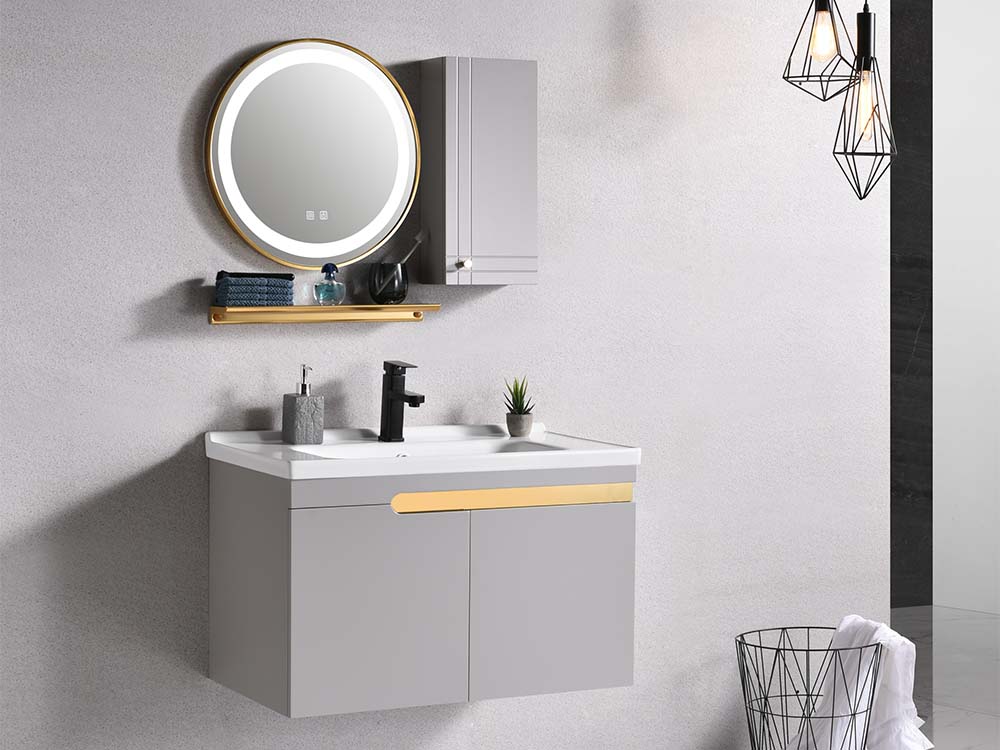Today we will talk about how to extend the service life of bathroom cabinets. As we all know, bathroom cabinets are an indispensable part of every family bathroom. The overall appearance of the bathroom cabinet affects the overall atmosphere of the bathroom. However, because bathroom environments are often exposed to high humidity and are frequently used, bathroom cabinets are inevitably affected by dirt, moisture, and wear and tear. Therefore, maintaining and cleaning your bathroom cabinets is an important task to ensure that they stay beautiful and last longer. Here are some tips to help you maintain and clean your bathroom cabinets to ensure they stay in tip-top shape.
Part One: Selection and Installation of Bathroom Cabinets
First let’s review the bathroom cabinet selection and installation process. The right bathroom cabinet material and correct installation method are the first steps in ensuring they remain beautiful and functional over the long term.
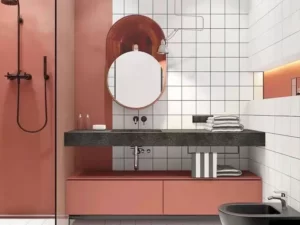
1.1 Choose the right material
Bathroom cabinets are often exposed to high humidity and temperature changes, so materials with moisture-resistant properties must be selected. Here are some common bathroom cabinet materials:
Engineered wood: Synthetic materials, such as MDF (medium density fiberboard) or particle board, are also a good choice for bathroom cabinets because they are highly resistant to moisture.
Solid wood: If you choose solid wood cabinets, make sure they are treated to resist moisture. Hardwoods such as teak, oak, and willow are often good choices.
Metal: Metal cabinets are often used in industrial or modern style bathrooms. Stainless steel and aluminum alloys are commonly used metal materials that resist rust.
Plastic: Plastic cabinets are lightweight and will not rust, but may not be as aesthetically pleasing as other materials.
1.2 Installation location and method
The installation location and method of bathroom cabinets also affect their maintenance and cleaning. Here are some suggestions for installation:
Avoid installing bathroom cabinets directly near a shower or bathtub to reduce direct contact with moisture.
Make sure your bathroom cabinets are securely installed to prevent them from loosening or wobbling.
Use water-resistant glue and sealant to seal the gaps between bathroom cabinets and walls to prevent moisture penetration.
Part 2: Bathroom Cabinet Maintenance
Once you have selected and correctly installed your bathroom cabinets, the next step is maintenance to ensure they stay in good condition. Here are some key maintenance recommendations.
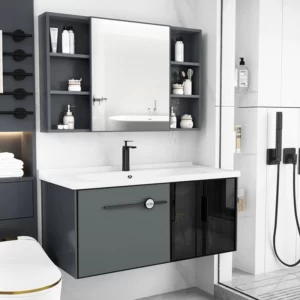
2.1 Regular inspection
It is important to check the condition of your bathroom cabinets regularly. Check cabinets, drawers and doors for looseness or damage. If any problems are discovered, fix them promptly to prevent them from getting worse.
2.2 Cleaning
Bathroom cabinet cleaning is an important part of maintenance. Not only do you need to keep the outside clean, but you also need to clean the inside regularly. Here are some tips for cleaning bathroom cabinets:
Exterior Cleaning: Wipe the exterior of your bathroom cabinets with a mild detergent and a soft cloth. Avoid using cleaners that contain acids or abrasives as they may damage the surface.
Interior Cleaning: Regularly clean the interior of your bathroom cabinets, including drawers and shelves. Keep your space tidy by removing expired medicines and cosmetics.
Avoid water accumulation: Make sure water does not accumulate inside the bathroom cabinets as this can cause damage to wood and other materials. Use waterproof mats or containers to store items to prevent liquids from penetrating.
2.3 Protection against moisture and mold
Bathroom cabinets are susceptible to moisture and mold, so precautions must be taken:
Use an exhaust fan: Make sure you have an exhaust fan in your bathroom to help remove excess moisture.
Maintain ventilation: Open windows regularly to ensure air circulation.
Use a dehumidifier: During seasons or areas with high humidity, using a dehumidifier can help reduce humidity.
Clean Mold: If mold is found, clean it up promptly with an appropriate mold cleaner.
2.4 Avoid direct contact with chemicals and hot items
Avoid direct contact of strongly acidic or alkaline chemicals with bathroom cabinet surfaces as these chemicals may damage the cabinets. Also, avoid placing hot items, such as irons or hot water bottles, on countertops to avoid leaving burn marks.
Part Three: Bathroom Cabinet Maintenance
Bathroom cabinet maintenance is not only about appearance, but also about its functionality and longevity. Here are some important aspects of maintaining your bathroom cabinets.
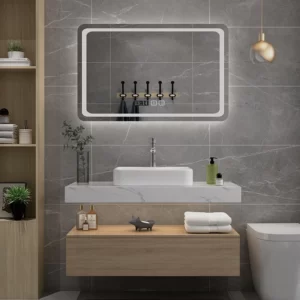
3.1 Repair damage
If you notice damage to your bathroom cabinets, such as broken drawer tracks or worn door handles, get them repaired promptly. Failure to repair these issues may result in more severe damage.
3.2 Painting and sealing
If your bathroom cabinets are made of wood, regularly check the finish for paint or sealing. If the paint is found to be peeling or the sealing layer is damaged, it should be repaired in time. Repainting or resealing can protect the wood from moisture and moisture.
3.3 Replacement accessories
If drawer handles, door handles, or other accessories are worn or damaged, consider replacing them. Not only does this enhance the appearance of your bathroom cabinets, it also helps ensure their proper use.
3.4 Control weight
Bathroom cabinets have a limited load-bearing capacity, so make sure not to overload the cabinet. Avoid storing heavy items in cabinets to prevent drawers or shelves from becoming deformed or damaged.
Part 4: Common problems and solutions for bathroom cabinets
Although maintaining and cleaning your bathroom cabinets can extend their lifespan, there are still some common problems that sometimes arise. Here are some possible problems and how to fix them.
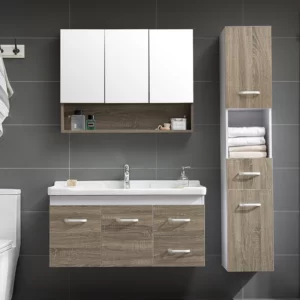
4.1 Wood expansion and contraction
Wooden bathroom cabinets may have problems with expansion and contraction due to the high humidity in the bathroom. This can cause the drawer to be difficult to push or pull, or the door to not close.
Solution: Use appropriate sealants and paints to reduce the likelihood of wood getting damp. If there are already problems with the cabinets, you can try to repair the damaged parts or replace damaged drawers and doors.
4.2 Rusty
Metal bathroom cabinets can rust, especially in environments with high humidity.
Solution: Clean and dry metal surfaces regularly to reduce the possibility of rust. If rust has appeared, you can use sandpaper to gently remove the rust, and then repaint or use anti-rust paint.
4.3 Stains and wear
Bathroom cabinets may show stains and wear on their surfaces, affecting their appearance.
Solution: Use a mild detergent and a soft cloth to clean the cabinet surface to remove stains. For more severe wear and tear, consider repainting or using a coating repair product.
4.4 Drawers and doors are not aligned
Drawers and doors may become misaligned due to use and moisture.
Solution: Check drawer rails and door hinges for looseness or damage. If they are loose, tighten them. If damaged, consider replacing them. Also, make sure the cabinet itself is not tilted so that drawers and doors remain level.
In conclusion
Maintaining and cleaning your bathroom cabinets is a critical step in ensuring they stay beautiful and last longer. Choosing materials suitable for your bathroom environment, installing your bathroom cabinets correctly, inspecting and cleaning them regularly, and fixing problems promptly are all keys to ensuring your bathroom cabinets stay in top condition over the long term. By following the advice above, you can ensure that your bathroom cabinets will still look like new for years to come, adding beauty and functionality to your bathroom.

